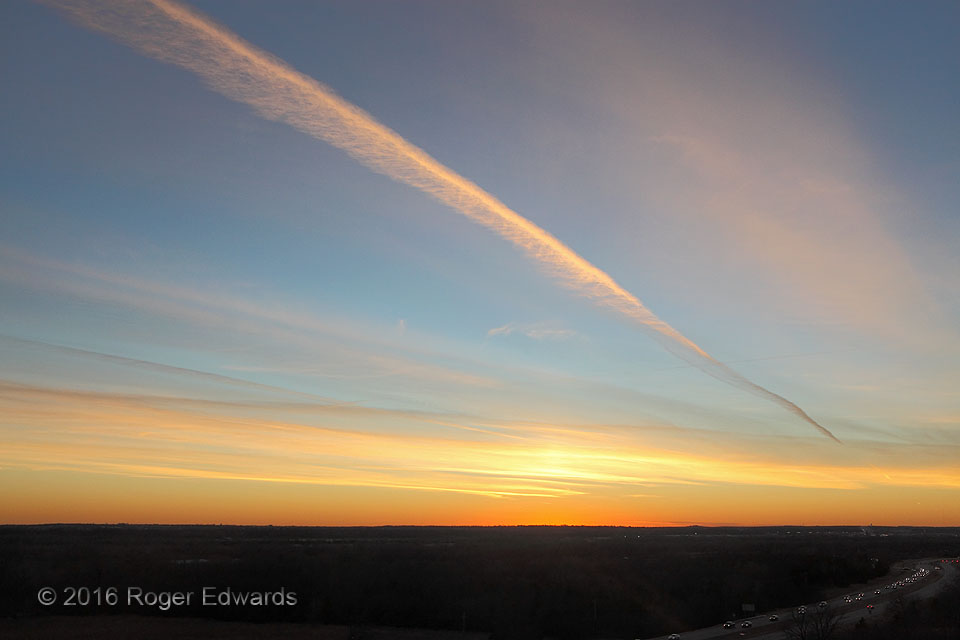 Condensation trails (contrails, for short) form as very hot, relatively moisture-rich air from jet exhaust cools and decompresses rapidly amidst surrounding, much colder and low-pressure air at high altitudes. Moisture in the exhaust plume condenses into ice crystals that linger for varying amounts of time, depending on humidity and winds in the surrounding air. Drier air will evaporate the cloud material sooner. Strong, horizontally shearing or turbulent winds will deform or mix away the contrail faster than weak winds and/or fairly smooth and uniform flow. Being clouds, they often reflect solar radiation (insolation) spaceward, with dense contrail concentrations noticeably reducing the amount of insolation reaching the ground. In this case, just after sunset, the contrails reflected sunlight back toward the ground. What made this scene even more photogenic and interesting was the transition of the contrail’s position from mostly lit to shadowed in the background, thanks to some distant cirrus clouds. A faint, thin contrail can be seen crisscrossing the main one near the shadow’s edge, at right middle. Soon the entire scene’s tones would deepen richly as the elements shifted across the sky, and new elements developed.
Norman OK (9 Feb 16) Looking WSW
35.1814, -97.44
Condensation trails (contrails, for short) form as very hot, relatively moisture-rich air from jet exhaust cools and decompresses rapidly amidst surrounding, much colder and low-pressure air at high altitudes. Moisture in the exhaust plume condenses into ice crystals that linger for varying amounts of time, depending on humidity and winds in the surrounding air. Drier air will evaporate the cloud material sooner. Strong, horizontally shearing or turbulent winds will deform or mix away the contrail faster than weak winds and/or fairly smooth and uniform flow. Being clouds, they often reflect solar radiation (insolation) spaceward, with dense contrail concentrations noticeably reducing the amount of insolation reaching the ground. In this case, just after sunset, the contrails reflected sunlight back toward the ground. What made this scene even more photogenic and interesting was the transition of the contrail’s position from mostly lit to shadowed in the background, thanks to some distant cirrus clouds. A faint, thin contrail can be seen crisscrossing the main one near the shadow’s edge, at right middle. Soon the entire scene’s tones would deepen richly as the elements shifted across the sky, and new elements developed.
Norman OK (9 Feb 16) Looking WSW
35.1814, -97.44Contrail
 Condensation trails (contrails, for short) form as very hot, relatively moisture-rich air from jet exhaust cools and decompresses rapidly amidst surrounding, much colder and low-pressure air at high altitudes. Moisture in the exhaust plume condenses into ice crystals that linger for varying amounts of time, depending on humidity and winds in the surrounding air. Drier air will evaporate the cloud material sooner. Strong, horizontally shearing or turbulent winds will deform or mix away the contrail faster than weak winds and/or fairly smooth and uniform flow. Being clouds, they often reflect solar radiation (insolation) spaceward, with dense contrail concentrations noticeably reducing the amount of insolation reaching the ground. In this case, just after sunset, the contrails reflected sunlight back toward the ground. What made this scene even more photogenic and interesting was the transition of the contrail’s position from mostly lit to shadowed in the background, thanks to some distant cirrus clouds. A faint, thin contrail can be seen crisscrossing the main one near the shadow’s edge, at right middle. Soon the entire scene’s tones would deepen richly as the elements shifted across the sky, and new elements developed.
Norman OK (9 Feb 16) Looking WSW
35.1814, -97.44
Condensation trails (contrails, for short) form as very hot, relatively moisture-rich air from jet exhaust cools and decompresses rapidly amidst surrounding, much colder and low-pressure air at high altitudes. Moisture in the exhaust plume condenses into ice crystals that linger for varying amounts of time, depending on humidity and winds in the surrounding air. Drier air will evaporate the cloud material sooner. Strong, horizontally shearing or turbulent winds will deform or mix away the contrail faster than weak winds and/or fairly smooth and uniform flow. Being clouds, they often reflect solar radiation (insolation) spaceward, with dense contrail concentrations noticeably reducing the amount of insolation reaching the ground. In this case, just after sunset, the contrails reflected sunlight back toward the ground. What made this scene even more photogenic and interesting was the transition of the contrail’s position from mostly lit to shadowed in the background, thanks to some distant cirrus clouds. A faint, thin contrail can be seen crisscrossing the main one near the shadow’s edge, at right middle. Soon the entire scene’s tones would deepen richly as the elements shifted across the sky, and new elements developed.
Norman OK (9 Feb 16) Looking WSW
35.1814, -97.44